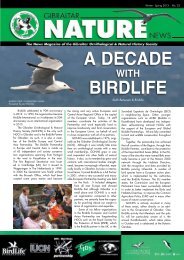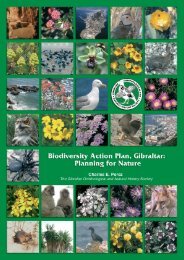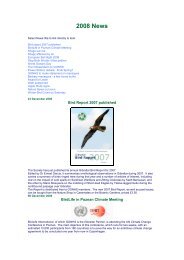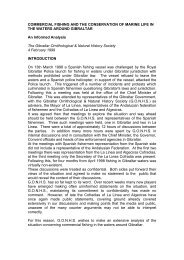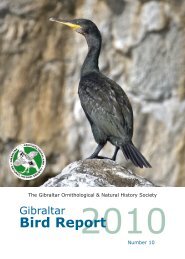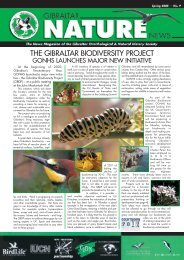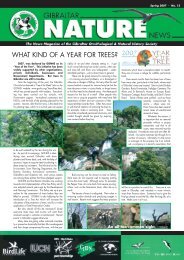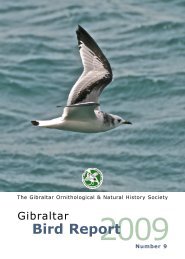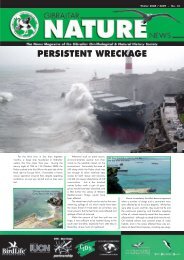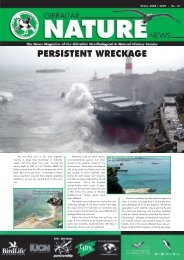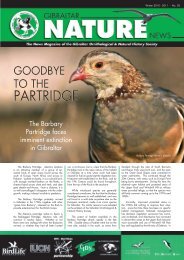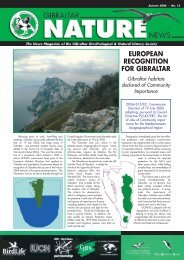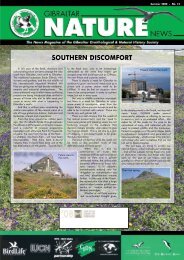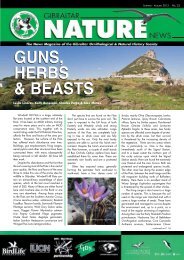Upper Rock Nature Reserve: A Management and Action Plan
Upper Rock Nature Reserve: A Management and Action Plan
Upper Rock Nature Reserve: A Management and Action Plan
Create successful ePaper yourself
Turn your PDF publications into a flip-book with our unique Google optimized e-Paper software.
15.3 Discussion<br />
15.4 Recommendations<br />
References<br />
Gibraltar Ornithological <strong>and</strong> Natural History Society - GONHS<br />
The Yellow-legged Gull<br />
It is gratifying to see that the Gibraltar Government has had the confidence to confer the<br />
responsibility of the management of the yellow-legged gull population to GONHS. In the<br />
past, culling was launched primarily to safeguard the aircraft l<strong>and</strong>ing at RAF Gibraltar. This<br />
did not stem the huge increase in the population, which was due in part to the expansion of<br />
the human population in the region. This resulted in several rubbish tips that were targeted<br />
as a food source by the gulls. However, the Los Barrios tip may soon close, <strong>and</strong> this could<br />
have a serious <strong>and</strong> welcome impact on the gull population in Gibraltar. This factor may contribute<br />
to the eventual decrease in numbers, but the authorities must not be complacent. The<br />
problem needs continual control <strong>and</strong> systematic culling if these numbers are to be maintained<br />
at an adequate level that will ensure the impact to the general public is kept at a minimum.<br />
1) There is a need to reconfigure <strong>and</strong> analyse the gull cull strategy of the last decade in<br />
order to prepare the ground for the next ten years. This analysis has been partly done in the<br />
paper by Cortes et al. (2004) ‘The Control of the Yellow-legged Gull in Gibraltar’, which deals<br />
with the matter more thoroughly than the overview that this chapter provides.<br />
2) Prepare a gull control management programme based on the research <strong>and</strong> experience<br />
gained over the last few years. This plan to collaborate with the general management plan<br />
for the <strong>Upper</strong> <strong>Rock</strong> <strong>Nature</strong> <strong>Reserve</strong>, since a large proportion of Gibraltar’s gull population<br />
breeds in or around the <strong>Nature</strong> <strong>Reserve</strong>.<br />
yellow-legged gulls<br />
• Cortes, J. C., Finlayson, J. C., Mosquera, M. A., Garcia, E. F. J., (1980) The Birds of Gibraltar. Gibraltar. Gibraltar Bookshop.<br />
• Cortes, J. C., Shaw, E., Blair, M., C<strong>and</strong>elin, G., (2003) The control of the Yellow-legged Gull, Larus michahellis, in Gibraltar. Almoraima, in press.<br />
• Finlayson, J. C. (1992) Birds of the Strait of Gibraltar. London: T. &A. D. Poyser Ltd.<br />
• GOS (1980) Report on Herring Gull Cull at Gibraltar. Spring 1980. Gibraltar: Gibraltar Ornithological Society.<br />
• Irby, L. H. (1895) The Ornithology of the Straits of Gibraltar, 2nd Ed. London: Taylor & Francis.<br />
• Saunders, H. (1871) A list of the birds of southern Spain. Ibis, (3)1: 54-68, 205-225, 384-402.<br />
• Verner, W. (1909) My life among the wild birds of Spain. London: John Bale, Sons & Danielsson, Ltd.<br />
- 179 -



